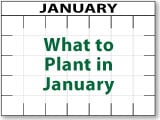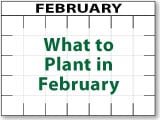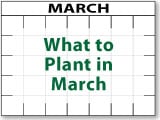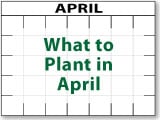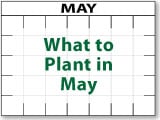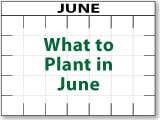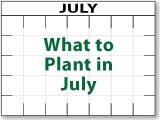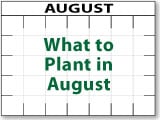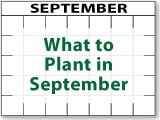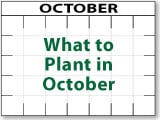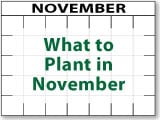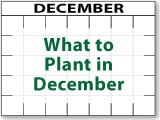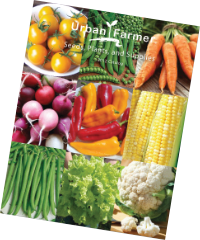What to Plant Now
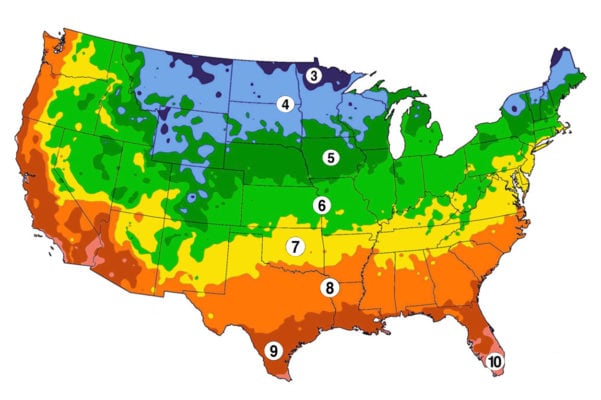
January
#

January is a great time to start planning what vegetable varieties to be grown in the garden. Look through your catalogs and find the vegetable seeds for your garden. Some flower varieties should be started in January. In a warmer environment you can plant certain vegetables, but must be ready for a frost. Indoor herbs are always great to grow in a sunny windowsill.
Tomatoes, Peppers & Eggplants (Zones 8-10):
If you live in Zones 8-10, get a head start on the growing season by starting your tomato, pepper and eggplant seeds indoors. Most tomatoes and peppers will take 6-8 weeks to reach transplant size so plan according to your climate!
Learn More: How to Grow Tomatoes, How to Grow Peppers, How to Grow Eggplant
Suggested tomato varieties: Brandywine, Cherokee Purple, Roma, Sweetie, Heirloom Blend
Suggested pepper varieties: California Wonder, Early Jalapeno, Sweet Banana, Super Chili
Suggested eggplant varieties: Black Beauty, Little Finger
B
roccoli (Zones 8-10):
If you live in a warmer climate, like Zones 8-10, and can find a quick growing Broccoli variety, you can harvest until it bolts in the hot summer sun!
Learn More: How to Grow Broccoli
Suggested varieties: Calabrese, De Cicco
Onions (Zones 8-10):
Late January is a great time to start your onion seeds indoors if you live in Zones 8-10. For Zones 3-7 start your onion seeds in late February. Let the onions grow to 5-6 inches tall and cut tops off so they will be only 3 inches. Repeating this until they are transplanted helps strengthen the roots and health of the onions.
Learn More: How to Grow Onions
Suggested varieties: Sweet White Walla Walla, Candy Hybrid, Yellow Sweet Spanish, Nebuka Evergreen
Herbs (Zones 3-10):
Herbs are definitely the most popular indoor plant to grow throughout the winter months in any Zone. Try your hand at these 5 most popular herbs. Also check out the Urban Farmer Herb Kit
Learn More: How to Grow Herbs
Suggested varieties: Basil, Chives, Oregano, Parsley, Thyme
Flowers (Zones 8-10):
Now is a great time to get your spring flowers germinating and ready for spring! There are many different varieties of annuals and perennials with different grow times. Pay attention to grow times so that your flowers are ready to be planted after last frost. Below are some good varieties to start in January if you are in Zone 8-10 for a last frost in March and April!
Annuals: Zinnias, Marigolds, Geraniums
Perennials: Rudbeckias, Daisies, Poppies, Coneflowers
February

Get your garden planning started! In some warmer locations, you can begin sowing your vegetable seeds outdoors. For cooler areas, February is a great time to sow your tomatoes and peppers. You should start drawing out your garden for all the vegetables you want to grow. In late February, there are several cool weather vegetables you can directly sow out in the garden.
Broccoli (Zones 7-10):
If you live in Zones 7-10, and can find a quick growing Broccoli variety, you can harvest until it bolts in the hot summer sun!
Learn More: How to Grow Broccoli
Suggested variety: De Cicco
Herbs (Zones 3-10):
Herbs are definitely the most popular indoor plant to grow throughout the winter months in any Zone. Plant heat loving herbs like basil, oregano, thyme and sage. Also check out the Urban Farmer Herb Kit
Learn More: How to Grow Herbs
Suggested varieties: Italian Basil, Greek Oregano, French Thyme, Broadleaf Sage
Lettuce (Zones 7-10):
In Zones 7-10, start a crop of salad mix greens that gets bright sun, but not all day. Great for spring crops until the lettuce begins to bolt in the summer sun!
Learn More: How to Grow Lettuce
Suggested Varieties: Buttercrunch, Mesclun Mix, Black Seeded Simpson
Onions (Zones 7-10):
Get those onion seeds growing! Zones 7-10 should plant long day onions, and Zones 3-6 should plant short day onions. Be careful to select an onion variety appropriate for your climate!
Learn More: How to Grow Onions
Suggest varieties: Sweet White Walla Walla, Red Creole, Yellow Spanish, Candy Hybrid
Peppers (Zones 7-10):
Fresh, crisp peppers are a garden favorite. Peppers take up little space and can produce high yields when planted close together. Plant as many different varieties as possible! They come small, big, hot, mild, and an array of different colors. For Zones 7-10, start seeds 8-10 weeks before your last frost date indoors for best results.
Learn More: How to Grow Peppers
Suggested varieties: California Wonder, Early Jalapeno, Sweet Banana, Super Chili
Tomatoes (Zones 7-10):
The most popular garden vegetable! Growing tomatoes is not only fun, but treats you to some of the best tasting fruits in the world. Tomatoes come in many colors, shapes, taste, and sizes. Grow a few varieties every year to find your favorites! For Zones 7-10 start seeds 6-8 weeks before your last frost date indoors for best results.
Learn More: How to Grow Tomatoes
Suggested varieties: Brandywine, Cherokee Purple, Siberian, Roma, Heirloom Blend
Annual and Perennial Flowers (Zones 7-10):
Now is a great time to get your spring flowers germinating and ready for spring! There are many different varieties of annuals and perennials with different grow times. Pay attention to grow times so that your flowers are ready to be planted after last frost. Below are some good varieties to start in January if you are in Zone 7-10 for a last frost in March and April!
Annuals: Zinnias, Marigolds, Geraniums
Perennials: Rudbeckias, Daisies, Poppies, Coneflowers
March

It’s finally March! March is the perfect time to get those tomato and pepper seeds started indoors so they can be ready for an early spring planting! Also now is a great time to start planting cool weather vegetables that can withstand those last frost days of March and April.
Beets (Zones 7-10):
Beets are a tasty root vegetable edible for both its bulb and green tops. Beets prefer cooler weather and can be grown in early spring to late summer. For Zones 7-10, sow beets now for a fast, early summer treat!
Learn More: How to Grow Beets
Suggested variety: Golden Detroit
Broccoli (Zones 5-10):
Broccoli is a hardy, cool-season vegetable bringing colorful green nutrients to the table. If you live in Zones 5-10 and can find a quick growing Broccoli variety, you can harvest in late spring until it bolts in the hot summer sun!
Learn More: How to Grow Broccoli
Suggested varieties: De Cicco, Spring Raab
Cabbage (Zones 5-10):
Cabbage is one of the easier plants to grow in the garden as it is a hardy vegetable that comes in different colors and sizes. In Zones 5-10, be sure to select a variety that is right for your location (size and maturity length). Fertilize and water when cabbage head begins to form!
Learn More: How to Grow Cabbage
Suggested varieties: Late Flat Dutch, Golden Acre, Michihili
Carrots (Zones 5-10):
Other than the typical orange, carrots can be found in red, white, rainbow and purple colors. For Zones 5-10, start carrot seeds indoors so you can transplant them outdoors in early to mid May.
Learn More: How to Grow Carrots
Suggested varieties: Atomic Red, Black Nebula
Cauliflower (Zones 5-10):
Cauliflower varieties generally do best when started in the cool weather of spring. They are easy to grow under most conditions and will hold well. Zones 5-10, start seeds 4-7 weeks before the last frost depending on length of season.
Learn More: How to Grow Cauliflower
Suggested varieties: Amazing, Snow Crown
Corn (Zones 8-10):
Corn is one of the most rewarding and fast growing crops to grow! Corn is delicious when cooked only minutes after being pulled off the stalk. For Zones 8-10, try a small plot of corn after the last spring frost, working your way to a large field of several varieties.
Learn More: How to Grow Corn
Suggested varieties: Early Golden Bantam , Ambrosia, Sweet G90
Cucumbers (Zones 5-10):
Fast growing vine or bush cucumber plants can produce an abundance of delicious fruits. Be careful to pick a variety for the space you have in your garden! Vine cucumbers can be the best tasting, but need far more space than bush varieties. For Zones 5 and 6, start seeds indoors so you can transplant them outdoors between April and June. Warmer areas can sow directly two weeks after the last frost.
Learn More: How to Grow Cucumbers
Suggest varieties: Spacemaster 80, Green Finger, Manny
Eggplants (Zones 5-10):
Eggplants are delicious in various cuisine, but also make to be a great meat substitute for its hardy, tender texture. Start eggplant seeds indoors up to 10 weeks before the last frost date.
Learn More: How to Grow Eggplant
Suggest varieties: Black Beauty, Little Finger
Herbs (Zones 3-10):
Herbs are great to grow in order to add fresh flavors to any dish. For Zones 5-10, herbs can start to be transplanted outdoors. In any Zone, herbs are definitely the most popular indoor plant to grow year-round. Also check out the Urban Farmer Herb Kit for a variety of herbs!
Learn More: How to Grow Herbs
Suggested varieties: Sweet High Oil Basil, Standard Chive, Vulgaris Thyme, Bouquet Dill
Lettuce (Zones 5-10):
Lettuce is a great source of Vitamin A and will add color to any tossed salads for a summer treat. For Zones 5-10, start a crop of salad mix greens 4-6 weeks before the last frost that gets bright sun, but not all day. Great for late summer and early fall crops!
Learn More: How to Grow Lettuce
Suggested Varieties: Gabriella, Garden Leaf Blend, Dwarf Romaine
Melons (Zones 7-10):
Melons are a sweet and colorful addition to summer meals and are great for a home garden. For Zones 7-10, start seeds indoors for a head start on your summer garden. Great for hot, long summers and a staple for summer picnics and family fun!
Learn More: How to Grow Melons
Suggested varieties: Honeydew Green Flesh, Honey Dew Stutz Supreme, Rich Sweetness
Onions (Zones 5-10):
Get those onion seeds growing! Be careful to select an onion variety appropriate for your garden zone. Northern areas should plant long day onions, and Southern regions should plant short day onions. If you live in Zones 5-10, you should start transplanting your onions outdoors.
Learn More: How to Grow Onions
Suggest varieties: Sweet White Walla Walla, Red Creole, Yellow Spanish, Candy Hybrid
Peas (Zones 5-10):
Peas are a cool-weather vegetable that will flourish in the spring. For Zones 5-10, green peas and sugar peas are good to start 4 to 6 weeks before the last spring frost to yield a summer harvest.
Learn More: How to Grow Peas
Suggested varieties: Sugar Snap, Alaska
Peppers (Zones 5-10):
The fresh, crisp taste of peppers are a garden favorite. Peppers take up little space and can produce high yields when planted close together. Plant as many different varieties as possible! They come small, big, hot, mild, and an array of different colors. For Zones 5-10, start seeds 6-12 weeks before your last frost date indoors for best results.
Learn More: How to Grow Peppers
Suggested varieties: California Wonder, Early Jalapeno, Sweet Banana, Rainbow Blend Bell
Spinach (Zones 5-10):
Spinach is a tasty cool weather vegetable and will produce until the hot weather of summer. For Zones 5-10, planting in early March will ensure you have plenty of harvest before bolting!
Learn More: How to Grow Spinach
Suggested varieties: Red Kitten, Renegade
Summer Squash (Zones 5-10):
Summer Squash is a very versatile plant to grow with many options. For Zones 5-10, starting in March or 3-4 weeks before the last frost and sowing in June will lead to fresh squash and zucchini to enjoy during the the hot summer.
Learn More: How to Grow Squash
Suggested Varieties: Cocozelle, Waltham Butternut
Tomatoes (Zones 5-10):
Tomatoes are the most popular garden vegetable to grow! Growing tomatoes is not only fun, but also treats you to some of the best tasting fruits in the world. Varieties can come in many colors, shapes, taste and sizes. Start growing a few varieties every year to find your favorites! For Zones 5-10, start seeds 6-8 weeks before your last frost date indoors for best results.
Learn More: How to Grow Tomatoes
Suggested varieties: Betty, Cherokee Purple, Vintage Wine, Sweet Million, Tasty Evergreen
April

Yes, Yes, Yes! April is finally here meaning that your garden soil is finally warming up! April is the best time to plant most of your vegetable seeds after your last frost. It’s still not too late to plant tomatoes and peppers from seeds as well. Be sure to check your gardening zone for last frost dates.
Beans (Zones 3-10):
There are two main kinds of beans found in gardens, bush beans and pole beans. Start planting both bush and pole beans now that the soil and air are warmed up as they should not have been started indoors. Try a continual 7-10 day sowing of different varieties, this will give you continual bean crops and not one large harvest with wasted crop!
Learning More: How to Grow Beans
Suggested varieties: French Garden, Golden Wax
Beets (Zones 3-10):
Beets are a perfect cool-weather vegetable that come in a variety of hues and shapes. All Zones can sow beets now for a fast, early summer treat!
Learn More: How to Grow Beets
Suggested Varieties: Early Wonder , Chioggia
Cabbage (Zones 3-10):
Cabbage is one of the easier plants to grow in the garden. Sown in April will lead to a great summer harvest! Select a variety that is right for your location (size and maturity length) and be sure to fertilize and water when cabbage head begins to form.
Learn More: How to Grow Cabbage
Suggested varieties: Late Flat Dutch, Golden Acre, Michihili
Carrots (Zones 3-10):
Carrots are a tasty summer treat for both humans and pets. Sowing in April will give an early summer crop!
Learn More: How to Grow Carrots
Suggested varieties: Little Finger, Scarlet Nantes, Rainbow Mix
Corn (Zones 3-10):
Corn is a fast growing crop! Corn is delicious when grilled, boiled or steamed fresh off the stalk. Try a small plot of corn two weeks after the last frost,, working your way to a large field of several varieties.
Learn More: How to Grow Corn
Suggested varieties: Honey Select Sweet, obsession, Butter and Sugar
Cucumbers (Zones 3-10):
Fast growing vine or bush cucumber plants can produce an abundance of cucumber fruits for a summer harvest. Be careful to pick a variety for the space you have in your garden. Cucumbers can be transplanted three weeks after being started or planted directly two weeks after the last spring frost.
Learn More: How to Grow Cucumbers
Suggested varieties: Spacemaster 80, Boston Pickling, Burpless Bush Slicer
Eggplants (Zones 3-10):
Eggplants are a great meat substitute and can come in different colors of white, orange, light purple and various shapes, for an attractive summer harvest.
Learn More: How to Grow Eggplant
Suggested varieties: Florida Market High Bush, Rosa Bianca
Herbs (Zones 3-10):
Herbs are great to grow inside year-round, but if you want to plant outside now you can start to plant heat loving herbs like basil, oregano, cilantro thyme and sage.
Learn More: How to Grow Herbs
Suggested varieties: Italian Basil, Greek Oregano, Slow Bolt Cilantro, French Thyme, Broadleaf Sage
Lettuce (Zones 3-10):
Lettuce is a fast grower, so you can stagger the plantings for a continuous harvest. Sowing lettuce in late spring is great for late summer and early fall crops!
Learn More: How to Grow Lettuce
Suggested Varieties: Parris Island Cos, Garden Leaf Blend, Iceberg
Melons (Zones 3-10):
Melons are great for hot, long summers and a staple for summer picnics and family fun! Start seeds indoors and transplant outdoors after 6-8 weeks.
Learn More: How to Grow Melons
Suggested varieties: Tasty Bites, Honey Rock, Rocky Ford Green Flesh
Onions (Zones 3-10):
If you haven’t already, start planting your onions! Be careful to select an onion variety appropriate for your garden zone. If you are in a cooler climate, plant long day onions and if you are in a warmer climate, plant short day onions.
Learn More: How to Grow Onions
Suggest variety: Red Grano, Ailsa Craig Exhibition, White Sweet Spanish
Peas (Zones 3-10):
Delicious green peas and sugar peas should be planted in April as they will flourish in the spring weather and will produce a May crop!
Learn More: How to Grow Peas
Suggested variety: Dwarf Grey Sugar, Sugar Ann, Alderman
Peppers (Zones 3-10):
Fresh, crisp peppers are a garden favorite and can produce high yields when planted close together. April is the time to sow as many different varieties as possible! They come small, big, hot, mild and an array of different colors. If you haven’t already planted your peppers outdoors, now is the time to do so!
Learn More: How to Grow Peppers
Suggested varieties: King of the North, Early Jalapeno, Joe Parker
Summer Squash (Zones 3-10):
Summer squash is such a tasty summer treat when roasted or grilled! Planting summer squash in late April will lead to fresh, tasty squash and zucchini in the summer.
Learning More: How to Grow Squash
Suggested Varieties: Scallop Blend, Early Prolific Straightneck, Garden Spineless
Tomatoes (Zones 3-10):
If you haven’t already started your tomato seeds, start them now! Homegrown tomatoes taste delicious fresh, or they can be used for canning, sauces and other recipes.
Learn More: How to Grow Tomatoes
Suggested varieties: San Marzano, Sun Gold, Bradley, Red Zebra
Annual and Perennial Flowers (Zones 8-10):
April is a great time to start to sow your flowers indoors so they can be ready for summer blooms!
Annuals: Marigolds, Zinnias
Perennials: Tidal Wave Silver Petunias
May
 Finally warm temperatures are here to stay and you don’t have to worry about that frost! You may think it’s too late to grow all your favorite vegetables from seeds, but warm May temperatures have made the soil perfect for sowing seeds. Warm soil will allow for fast germination and growing plants! Good choices are summertime kitchen garden staples like squash, beans, cucumbers and melons.
Finally warm temperatures are here to stay and you don’t have to worry about that frost! You may think it’s too late to grow all your favorite vegetables from seeds, but warm May temperatures have made the soil perfect for sowing seeds. Warm soil will allow for fast germination and growing plants! Good choices are summertime kitchen garden staples like squash, beans, cucumbers and melons.
Beans (Zones 3-10):
You can plant both bush and pole beans now that the soil and air are warmed up as beans should not be started indoors. Try a continual 7-10 day sowing of different varieties. This will give you an abundance of bean crops and not one large harvest with wasted crop.
Learn More: How to Grow Beans
Suggested varieties: Scarlet Runner, Kentucky Wonder, Colorful Garden Blend
Beets (Zones 3-10):
You still have time to sow beets now for a fast, yummy summer treat! To provide a continuous harvest, plant seeds in various locations with a three-week time difference.
Learn More: How to Grow Beets
Suggested Varieties: Detroit Dark Red, Bull’s Blood, Golden Detroit
Cabbage (Zones 3-10):
May is the time to transplant cabbage for a summer harvest. Cabbage plants do better when planted near herbs like dill and rosemary.
Learn More: How to Grow Cabbage
Suggested varieties: White Stem, Golden Acre, Brunswick
Carrots (Zones 3-10):
For a delicious fall crop, start carrots inside now so that they can be transplanted in mid-July. Try different colored varieties for making colorful stews and soups.
Learn More: How to Grow Carrots
Suggested varieties: Rainbow Mix, Dragon, Black Nebula
Corn (Zones 3-7):
Now that the weather is warmer and soil is above 55 degrees Fahrenheit, it is the perfect time to plant sweet corn for a delicious late summer to early fall harvest.
Learn More: How to Grow Corn
Suggested varieties: Peaches and Cream, Incredible, Butter and Sugar
Cucumbers (Zones 3-10):
Cucumbers can be directly sowed or transplanted after three weeks. Cucumbers can take up a lot of space so be careful to pick a variety for the space you have in your garden.
Learn More: How to Grow Cucumbers
Suggest varieties: Spacemaster 80, Boston Pickling, Sumter
Eggplants (Zones 3-10):
When the soil temperature reaches 60 degrees Fahrenheit, it is time to transplant your eggplants outside.
Learn More: How to Grow Eggplant
Suggested varieties: Black Beauty, Bride
Herbs (Zones 3-10):
Anytime year-round is the perfect time to plant heat loving herbs like basil, oregano, rosemary and sage indoors or outdoors!
Learn More: How to Grow Herbs
Suggested varieties: Italian Basil, Greek Oregano, Bouquet Dill, Broadleaf Sage
Melons (Zones 3-10):
Melons are great for hot, long summers and a staple for hot, long summer picnics and family fun!
Learn More: How to Grow Melons
Suggested varieties: Sugar Baby, Honeydew, Hales Best
Peppers (Zones 3-10):
Fresh, crisp peppers are a garden favorite. Peppers take up little space and can produce high yields when planted close together. It’s not too late to plant as many different varieties as possible! They come small, big, hot, mild, and an array of different colors.
Learn More: How to Grow Peppers
Suggested varieties: Carolina Reaper, Rainbow Blend Bell, California Wonder, Hot and Happy Mix
Summer Squash (Zones 3-10):
Sow summer squash now in May will lead to fresh squash and zucchini for July!
Learn More: How to Grow Squash
Suggested Varieties: Early Prolific Straightneck, Scallop Blend, Garden Spineless
Tomatoes (Zones 3-10):
May is the time to transplant your tomatoes if you haven’t already. Make sure to transplant to an area that gets full sun.
Learn More: How to Grow Tomatoes
Suggested varieties: SunSugar, Rio Grande, Sweet Seedless, Red Pear
June

Most fruiting plants like tomatoes, peppers, and eggplants should already be in the ground. Many vegetables will still grow and produce even more quickly from seed planted in early June when the soil is well warmed up and teeming with life depending on where you live.
Beans (Zones 3-8):
Beans are great for a June planting in Zones 3-8. Beans are fast growing in warm soil will give you a crop in as little as 35 days with some varieties.
Learn More: How to Grow Beans
Suggested varieties: Harvester, French Garden, Midori Giant
Beets (Zones 3-6):
Sow beets now in Zones 3-6 for a fast, mid-summer treat!
Learn More: How to Grow Beets
Suggested Varieties: Chioggia, Cylindra
Cabbage (Zones 3-7):
Cabbage is one of the easier plants to grow in the garden. Make sure to select a variety that is right for your location (size and maturity length). Be sure to fertilize and water when cabbage heads begins to form.
Learn More: How to Grow Cabbage
Suggested varieties: Copenhagen Market, White Stem, Red Acre
Carrots (Zones 3-7):
Planting carrots by mid-June in Zones 3-7 will yield a late summer crop that will keep in the garden until used.
Learn More: How to Grow Carrots
Suggested varieties: Parisian, Little Finger, Nantes
Corn (Zones 3-10):
One of the most rewarding and fast growing crops to grow in the summer. Corn is delicious when cooked only minutes after being pulled off the stalk. Try a small plot of corn, working your way to a large field of several varieties.
Learn More: How to Grow Corn
Suggested variety: Buttergold, Sweet G90, Honey Select Sweet
Cucumbers (Zones 3-8):
Fast growing vine or bush cucumber plants can produce an abundance of cucumber fruits. Be careful to pick a variety for the space you have in your garden. Vine cucumbers can be the best tasting but need far more space than bush varieties.
Learn More: How to Grow Cucumbers
Suggest varieties: Spacemaster 80, Muncher, Marketmore 76
Herbs (Zones 3-10):
All Zones can plant an herb garden indoors or outdoors, but now is the time to plant heat loving herbs like basil, oregano, thyme and sage.
Learn More: How to Grow Herbs
Suggested varieties: Italian Basil, Greek Oregano, Dill
Melons and Watermelons (Zones 3-8):
Tasty melons make for a great treat on hot, long summers and a staple for summer picnics and family fun.
Learn More: How to Grow Melons, How to Grow Watermelon
Suggested variety: Honey Dew Stutz Supreme, Bush Sugar Baby Watermelon, All Sweet Watermelon
Peas (Zones 3-5):
For Zones 3-5 and 6 depending on weather, green peas and sugar peas are good to plant in June, and will produce a great summer crop of fresh, crisp peas.
Learn More: How to Grow Peas
Suggested varieties: Sugar Snap, Green Arrow
Summer Squash (Zones 3-10):
Summer squash sowing in June will lead to the perfect fresh squash and zucchini in July and August.
Learn More: How to Grow Squash
Suggested Varieties: Cocozelle, Waltham Butternut
July

Even in the July heat there are still some great crops that can be planted that will keep your garden pumping out vegetables well into the fall.
Beans (Zones 3-8):
You can still plant both bush and pole beans since they love warm soil and air. Try a continual 7-10 day sowing of different varieties. This will give you continual bean crops for a fall harvest.
Learn More: How to Grow Beans
Suggested varieties: Blue Lake FM-1K Pole, Landreth Stringless, Strike
Brussels Sprouts (Zones 3-9):
Brussels Sprouts have a long harvest and can be planted and transplanted in July. This fall crop can be enjoyed roasted, boiled or eaten raw in thin shavings.
Learn More: How to Grow Brussels Sprouts
Suggested varieties: Long Island, Gustus
Broccoli (Zones 3-6):
For a delicious fall harvest, start broccoli now to produce a crop well into November.
Learn More: How to Grow Broccoli
Suggested varieties: Calabrese, Aspabroc Baby, Early Purple
Carrots (Zones 3-5):
Starting carrots or planting for cooler zones by mid-July yields a fall crop that will keep in the garden until used.
Learn More: How to Grow Carrots
Suggested varieties: Little Finger, Culinary Blend, Nantes
Corn (Zones 3-5):
Starting carrots or planting for cooler zones by mid-July yields a fall crop that will keep in the garden until used.
Learn More: How to Grow Corn
Suggested varieties: Bodacious, Sugar Buns, Early Golden Bantam
Cucumbers (Zones 3-8):
Fast growing vine or bush cucumber plants can produce an abundance of cucumber fruits for a delicious early fall harvest.. Be careful to pick a variety for the space you have in your garden. Vine cucumbers can be the best tasting but need far more space than bush varieties.
Learn More: How to Grow Cucumbers
Suggest varieties: Homemade Pickles, Double Yield, Sumter
Kale (Zones 3-9):
Planting kale mid-July through mid-August will yield an excellent harvest in the fall and winter.
Learn More: How to Grow Kale
Suggested variety: Blue Curled Scotch, Premier
August

August is an ideal time to plant seeds for a second gardening season that can be as productive as your major early spring plantings. Late summer is perfect for a delicious fall vegetable and herb harvest.
Beans (Zones 3-8):
Early August is the last practical sowing date for both bush and pole beans now that the soil and air are warmed up.
Learn More: How to Grow Beans
Cucumbers (Zones 3-9):
Starting vine or bush cucumbers in August will lead to a delicious fall harvest. Vine cucumbers can be the best tasting but need far more space than bush varieties.
Learn More: How to Grow Cucumbers
Suggest varieties: Spacemaster 80, Muncher, Marketmore 76
Flowers (Zones 3-8):
August is the perfect time to plant those flowers for a beautiful fall harvest. There are many varieties that can be planted this fall and start blooming early spring.
Suggested varieties: Marigolds, Alyssum, Snapdragons
Kale (Zones 3-9):
Planting kale now in mid-July through mid-August will yield an excellent harvest in the fall and winter.
Learn More: How to Grow Kale
Suggested varieties: Red Russian, Dwarf Siberian
Lettuce (Zones 3-8):
Sow lettuce in August for a fall crop. Try growing early harvest varieties that will produce a harvest before cold weather rolls in.
Learn More: How to Grow Lettuce
Suggested varieties: All The Year Round, Mesclun Salad Mix, Spicy Salad Blend
Peas (Zones 3-7):
Green peas and sugar peas are good to plant in August, and will produce a moderate fall harvest.
Learn More: How to Grow Peas
Suggested varieties: Tom Thumb, Cascadia, Wando
Radishes (Zones 3-9):
Radishes are one of the fastes growing vegetables around and are easy to grow. Plant now and you can have them ready in 30 days!
Learn More: How to Grow Radishes
Suggested varieties: Watermelon Radish, Comet, Black Spanish Round
Spinach (Zones 3-8):
Spinach is more of a cool weather vegetable and is great to grow in August for a tasty fall harvest.
Learn More: How to Grow Spinach
Suggested varieties: Red Kitten, Bloomsdale, Renegade
September

Although September marks the beginning of fall, there are still a few fast growing vegetables that can be planted this month and be harvested before the first frost in most gardening zones. Remember to keep your soil warm by removing all mulch and maybe try using a plastic sheet to trap heat into the soil. Try these vegetables below and you can still take advantage of your garden this fall.
Blueberries (Zones 3-10):
Fall is the perfect time to plant delicious blueberry plants. Planting in the fall will allow for good root growth and early growth this coming spring.
Learn More: How to Grow Blueberries
Suggested varieties: Bluecrop, Blueray
Broccoli (Zones 5-9):
If you live in a warmer zone and can find a quick growing Broccoli variety, you can plant now to harvest well into November.
Learn More: How to Grow Broccoli
Suggested varieties: Calabrese, Early Purple Sprouting
Flowers (Zones 3-10):
September is a great time to plant those fall flower bulbs. There are many varieties that can be planted this fall and start blooming early spring.
Suggested varieties: Asters, Calendulas, Cosmos
Garlic (Zones 3-10):
Garlic is a vegetable that can be planted in the fall for a larger and earlier harvest this coming spring.
Learn More: How to Grow Garlic
Suggested varieties: Italian Red, California Early, Music
Lettuce (Zones 3-10):
You can sow lettuce late summer for a fall crop. Be sure to grow fast maturing varieties.
Learn More: How to Grow Lettuce
Suggested Varieties: Gabriella, Romaine Trio Blend, Green Ice
Radishes (Zones 3-10):
Radishes are a quick and easy vegetable to grow. Plant now and you can have them ready in 30 days!
Learn More: How to Grow Radishes
Suggested variety: Butter Globe, Sparkler, French Breakfast
Spinach (Zones 3-9):
Spinach is more of a cool weather vegetable and is great to grow in September for a late fall/winter harvest.
Learn More: How to Grow Spinach
Suggested varieties: Bloomsdale, Olympia, Viroflay
October

October means that fall is here and many vegetables don’t have enough time to develop before your first frost. However, there are still a few fast crops that can be planted in October.
Flowers (Zones 5-10):
October is a great time to plant those fall flowers. There are many varieties that can be planted this fall and start blooming early spring.
Suggest varieties: Celosia, Asters, Dianthus
Garlic (Zones 5-10):
Garlic is a vegetable that can be planted in the fall for a larger and earlier harvest this coming spring.
Learn More: How to Grow Garlic
Suggested varieties: Elephant, Spanish Roja, Inchelium Red
Herbs (Zones 3-10):
Herbs are defiantly the most popular indoor plant to grow throughout the winter months. Try your hand at these 5 most popular herbs. Also check out the Urban Farmer Herb Kit
Learn More: How to Grow Herbs
Suggested varieties: Aroma 2 Basil, Standard Chive, Greek Oregano, Giant of Italy Parsley, French Thyme
November

Don’t be sad, you can still grow a lot of different plants inside in November. This is a great time of the year to clone some of your outside plants or grow them from seed indoors. Grow herbs on the windowsill!
Herbs (Zones 3-10):
Herbs are defiantly the most popular indoor plant to grow throughout the winter months. Try your hand at an indoor herb garden with lots of varieties. Also check out the Farmer Herb Kits
Learn More: How to Grow Herbs
Suggested varieties: Genovese Basil, Common Cilantro, Italian Plain Parsley
Indoor Flowers (Zone 3-10):
Growing flowers indoors can be a good way to pass the winter months. These beautiful flowers will brighten up your house and give off a nice aroma.
Suggested varieties: Celosia, Impatiens
Vegetables (Zones 8-10):
If you live in some warmer climates it is a perfect time to plant some vegetables. Try some of the cool weather vegetables that can survive now that the summer heat is over.
Learn More: How to Grow Vegetables
Suggested varieties: Lettuce, Radishes, Spinach, Broccoli, Carrots
December

December means that it is time to start planning your garden wherever you live. You can also try growing some fresh herbs inside on your kitchen windowsill.
Herbs (Zones 3-10):
Herbs are defiantly the most popular indoor plant to grow throughout the winter months. Try your hand at an indoor herb garden with a variety of herbs. Also check out the Urban Farmer Herb Kit
Learn More: How to Grow Herbs
Suggested varieties: Large Leaf Basil, Mammoth Long Island Dill, Creeping Thyme
Vegetables (Zones 8-10):
If you live in some warmer climates it is a perfect time to plant vegetables. Try some of the cool weather vegetables that can survive now that the summer heat is over.
Learn More: How to Grow Vegetables
Suggest varieties: Lettuce, Radishes, Spinach, Broccoli
